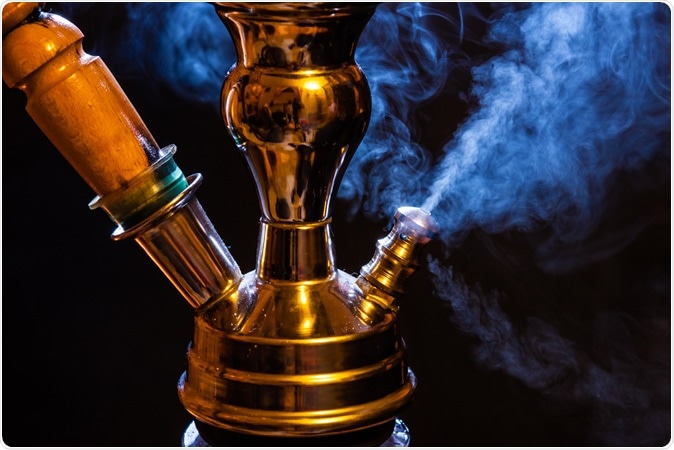With the decline in cigarette smoking, students have taken to other ‘safer’ forms of smoking, especially hookah smoking. However, a pioneering study shows that a single puff from a hookah exposes the smoker to as high a level of certain toxins as an entire cigarette does!

Image Credit: Jarry / Shutterstock
A fifth of all students, both in the US and in Europe, have sampled the hookah, a device which heats tobacco in an enclosed brazier (the “head”) over which heated charcoal is placed. The smoke from the burning charcoal and the heated tobacco is inhaled as a cooler aerosol, through a waterpipe. No smoke escapes from the hookah’s burning end (‘side-stream smoke’), unlike a cigarette, and a variety of tobacco flavors are available. Moreover, hookah smoking is by its nature a social activity, while the water through which the smoke is passed is thought to filter out many toxins. All these have added to the attraction of the hookah.
Scientists have already found that mainstream hookah smoke contains nicotine, nitrosamines, aromatic amines, polycyclic aromatic hydrocarbons (PAHs), volatile organic compounds, benzene, phenols, carbon monoxide, furans and heavy metals – a formidable list of poisons. From 2010 onwards studies have shown hookah smoking to be associated with respiratory and cardiovascular disease, periodontal disease, low birth weight, cancers and infections transmitted via the hookah’s common mouthpiece.
The team of researchers from the University of California, Irvine (UCI), built a special testing apparatus to analyze the smoke produced over one session of communal hookah smoking. They were looking at levels of carbon monoxide, volatile organic compounds (VOCs), and the size distribution and composition of nanoparticles.
According to researcher Veronique Perraud, older studies used samples from the filter used to capture the smoke from one whole session, which was used to arrive at a single data point. These offline analyses took much more time, and were not able to pick up less volatile gases or small particles.
However, she says, the current research used a different online technique. She says, “[By] testing emissions in the beginning, midpoint and end of a smoking session, we were able to show that a smoker is exposed to a higher quantity of ultrafine particles during the first 10 minutes compared to the rest of the time.”
This measurement pattern sets this study apart from previous studies on hookah smoking. The custom-built dilution flow tube included two mass spectrometers, one of which is a Thermal Desorption Chemical Ionization Mass Spectrometry, TDCIMS, built by the UCL’s Smith group. This enabled them to look at the chemical composition of the mainstream smoke, both gaseous and solid components, from one hookah session.
The apparatus was designed to include ultrafine particles, less than 100 nm in size, in the analysis. These minute particles are hazardous to the lungs as well as to the rest of the body because their size lets them penetrate deep into the lung airways, and when below 50 nm, they can cross the blood-brain barrier to affect the neurons of the brain.
Surprisingly, they found that one draw from the hookah contains as many of these fine particles as the smoke of one whole cigarette! This is probably due to nucleation of particles from the tobacco vapors, as larger particles are formed later in the session.
This is contrary to common belief which holds that hookah smoking filters the toxins from the mainstream smoke. The truth is that most of them pass through the water, and the finest particles may even form with greater ease because of the cooling produced by the water.
These facts were verified with a conventional tobacco mixture, a dark leaf unwashed tobacco, and a nicotine-free herbal hookah mixtures, which is claimed to be a healthier option. On the contrary, the researchers found that inhaled smoke from the herbal concoction was associated with greater levels of toxic gases. However, nicotine and other nitrogen products are generally lower in hookah smoke due to the lower temperature of the tobacco.
The mainstream smoke from the hookah contains carbon monoxide, a respiratory poison which prevents the binding of oxygen by hemoglobin in the blood, depriving the body’s tissues of oxygen. The tobacco or herbs in the hookah brazier burn on a charcoal bed, which is the chief source of CO and in fact, several people have suffered CO poisoning after hookah smoking. Switching to an electrical heating device reduces the levels by 90%, and even otherwise, the inhaled amount can be halved by using permeable leather piping instead of plastic.
Other reasons for the increased danger of hookah smoke include the larger volume of smoke inhaled with each hookah puff, and the increased amount of carbon monoxide (CO) produced by this instrument. In addition, a hookah session typically lasts longer than a cigarette.
Again, hookahs burn tobacco at a lower temperature, which alters the chemical composition of the smoke compared to the more complex composition of cigarette smoke. However, the levels of sugar derivatives and glycerol are higher in hookah smoke. Glycerol and its decomposition products dominate hookah smoke in the gas phase, while during the particulate phase sugar derivatives predominate. Decomposition of glycerol, which is a common food additive, leads to the formation of small aldehydes, like acrolein and acetaldehyde, which irritate body tissues and may lead to cancerous changes. It is noteworthy that over 90% of these are absorbed in the airways.
The researchers point out, “The large ultrafine particle number concentration is cause for concern and highlights the potential danger of regular waterpipe smoking.”
Journal reference:
Chemical characterization of nanoparticles and volatiles present in mainstream hookah smoke, Véronique Perraud, Michael J. Lawler, Kurtis T. Malecha, Rebecca M. Johnson, David A. Herman, Norbert Staimer, https://doi.org/10.1080/02786826.2019.1628342